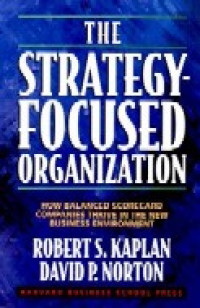
The Strategy-focused organization : how balanced scorecard companies thrive in the new business environment
| Gmd : Text
| Availability :
| 00000001536 | HD30.28 .K3544 2001 | (General Book) | Available - Ada |
In their previous book, The Balanced Scorecard, Robert Kaplan and David Norton unveiled an innovative "performance management system" that any company could use to focus and align their executive teams, business units, human resources, information technology, and financial resources on a unified overall strategy--much as businesses have traditionally employed financial management systems to track and guide their general fiscal direction. In The Strategy-Focused Organization, Kaplan and Norton explain how companies like Mobil, CIGNA, and Chemical Retail Bank have effectively used this approach for nearly a decade, and in the process present a step-by-step implementation outline that other organizations could use to attain similar results. Their book is divided into five sections that guide readers through development of a completely individualized plan that is created with "strategy maps" (graphical representations designed to clearly communicate desired outcomes and how they are to be achieved), then infused throughout the enterprise and made an integral part of its future. In several chapters devoted to the latter, for example, the authors show how their models have linked long-term strategy with day-to-day operational and budgetary management, and detail the "double loop" process for doing so, monitoring progress, and initiating corrective actions if necessary. --Howard Rothman
From The Industry Standard
In this fast-moving economy of big ideas and trendy business strategies, one can sometimes lose track of what's in and what's out. If the last round of big ideas (disruptive technologies and chasm-crossings) was about finding the right product and market, this year's model is about getting it done. As companies turn again to profitability and leveraging existing resources and assets, managers are gravitating toward ideas that help them execute their strategies.
The Strategy-Focused Organization, then, comes at an auspicious moment. In a follow-up to their influential and popular 1996 book The Balanced Scorecard, Harvard Business School professor Robert Kaplan and consultant David Norton take their popular ideas about measuring success and show how to build an organization that puts those ideas to use.
Kaplan and Norton have rolled out their balanced scorecard model in hundreds of companies, including such marquee clients as Cigna, Mobil and UPS. They have built a successful consulting practice based on it and are now seeing other books crop up about using their tool.
Like many consequential management devices, the balanced scorecard is fairly straightforward. The authors argue that companies all too often focus on the wrong numbers. Managers obsess over outcomes or lagging indicators instead of harder-to-measure factors such as cycle time, customer satisfaction and levels of innovation. The solution is a more balanced scorecard, and in the first book Kaplan and Norton go into great detail on how to build one.
The underlying principles here are not new. The authors build on a tradition of process-focused quality initiatives stretching from Six Sigma and Total Quality Management all the way back to Frederick Taylor's scientific management. Kaplan and Norton, however, move the notion forward somewhat by more explicitly linking their measures to successful outcomes. Employees more easily see how increasing cycle time or reducing defects, for example, can affect financial performance and customer satisfaction.
The scorecard describes and tracks a company's given goals. Kaplan and Norton argue in their new book, though, that their approach can also help managers execute those goals by acting as a sort of corporate superego. "Measurement creates focus for the future because the measures chosen by managers communicate to the organization what is important," they write, somewhat grandly claiming that at many companies their scorecard system "replaced the budget as the center for management processes. In effect, the balanced scorecard became the operating system for a new management process."
Kaplan and Norton deliver on the subtitle's promise of showing how companies use the balanced scorecard. While at times the book reads a bit like a Harvard Business School case write large no surprise, given that many of the examples cited were subjects of HBS case studies by the authors the book presents a wealth of finer points and stories about the tool in practice.
While the balanced scorecard promises great reward, it also calls for a large commitment. The authors suggest, for example, that every employee construct personalized balanced scorecards. They advocate regular, detailed communication of the numbers. Such practices can, if pursued too vigorously, channel an inordinate amount of time and energy to the process of "excellence" rather than the business of getting things done. Several quality-obsessed companies of the '90s fell prey to such habits.
Still, most companies could do far worse than overemphasize doing the right things. At a time when companies increasingly need to deliver on strategy rather than come up with the next big idea, Kaplan and Norton help pull together meaningful measures for a knowledge-based economy. A fairly simple idea, but as the authors argue, execution is everything.
(Source : Amazon.com)
| Series Title |
-
|
|---|---|
| Call Number |
HD30.28 .K3544 2001
|
| Publisher Place | Boston |
| Collation |
x, 400p.: ill.; 24cm.
|
| Language |
English
|
| ISBN/ISSN |
1578512506
|
| Classification |
HD30.28
|
| Media Type |
-
|
|---|---|
| Carrier Type |
-
|
| Edition |
-
|
| Subject(s) | |
| Specific Info |
-
|
| Statement |
-
|
| Content Type |
-
|
No other version available







